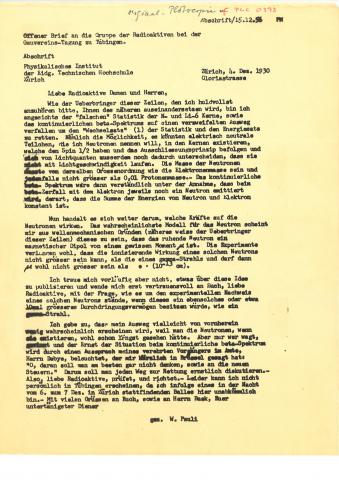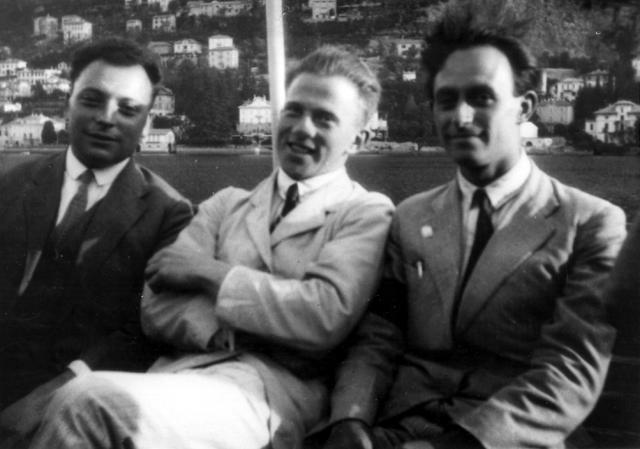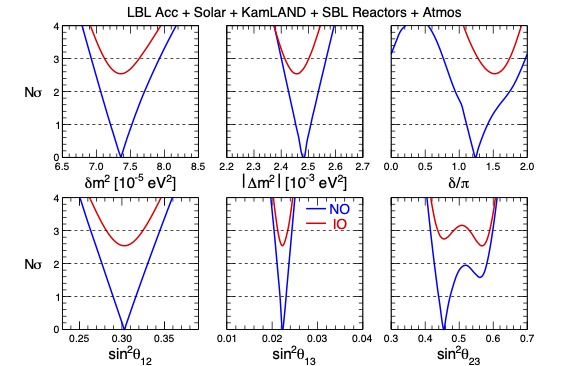Most of my researches have been dedicated to neutrino physics. Neutrinos are elusive subatomic particles that have intrigued scientists for decades due to their peculiar properties and mysterious behavior. Despite being one of the most abundant particles in the universe, neutrinos are notoriously difficult to detect and study due to their weak interactions with matter.
Pauli's letter of the 4th of December 1930
 Dear Radioactive Ladies and Gentlemen,
Dear Radioactive Ladies and Gentlemen,
As the bearer of these lines, to whom I graciously ask you to listen, will explain to you in more detail, how because of the "wrong" statistics of the N and Li6 nuclei and the continuous beta spectrum, I have hit upon a desperate remedy to save the "exchange theorem" of statistics and the law of conservation of energy. Namely, the possibility that there could exist in the nuclei electrically neutral particles, that I wish to call neutrons, which have spin 1/2 and obey the exclusion principle and which further differ from light quanta in that they do not travel with the velocity of light. The mass of the neutrons should be of the same order of magnitude as the electron mass and in any event not larger than 0.01 proton masses. The continuous beta spectrum would then become understandable by the assumption that in beta decay a neutron is emitted in addition to the electron such that the sum of the energies of the neutron and the electron is constant... I agree that my remedy could seem incredible because one should have seen these neutrons much earlier if they really exist. But only the one who dare can win and the difficult situation, due to the continuous structure of the beta spectrum, is lighted by a remark of my honoured predecessor, Mr Debye, who told me recently in Bruxelles: "Oh, It's well better not to think about this at all, like new taxes". From now on, every solution to the issue must be discussed. Thus, dear radioactive people, look and judge. Unfortunately, I cannot appear in Tubingen personally since I am indispensable here in Zurich because of a ball on the night of 6/7 December. With my best regards to you, and also to Mr Back. Your humble servant, W. Pauli
First proposed in 1930 by the physicist Wolfgang Pauli (on the right a photo of Pauli, Heisenberg and Fermi), neutrinos are fundamental particles that belong to the lepton family, along with the electron, muon, and tau particles. They are electrically neutral, they carry no electric charge, and they have an incredibly tiny mass, making them nearly massless in most contexts. This unique combination of properties gives neutrinos the ability to traverse vast distances through space without being significantly affected by electromagnetic forces.
Neutrinos are produced in various astrophysical processes, such as nuclear reactions in the Sun, supernovae explosions, and cosmic ray interactions with the Earth's atmosphere. They can also be generated in terrestrial experiments using particle accelerators or nuclear reactors. Despite
reactors. Despite
their abundance, neutrinos are extremely challenging to detect, requiring sophisticated and highly sensitive experiments.
One of the most significant breakthroughs in neutrino physics came in 2002 when the Sudbury Neutrino Observatory (SNO) in Canada provided the first experimental evidence that neutrinos change, or oscillate, between three different types: electron neutrinos, muon neutrinos, and tau neutrinos. This discovery revolutionized our understanding of neutrinos and established that they have nonzero masses.
Neutrino physics plays a crucial role in unraveling the mysteries of the universe, including the nature of dark matter, the behavior of supernovae, and the asymmetry between matter and antimatter. Neutrinos also offer a unique window into high-energy astrophysical phenomena, providing valuable insights into the workings of cosmic accelerators and the dynamics of neutron stars and black holes.
Global Analysis of neutrino data
A good part of my research activity has been focused on the global analysis of neutrino experiments.
Neutrino oscillation experiments aim to probe the phenomenon of neutrino flavor transformation, wherein neutrinos produced in one flavor state (electron, muon, or tau) can transition into another flavor state as they propagate through space. These flavor transitions are governed by the mixing of neutrino mass states, known as the Pontecorvo-Maki-Nakagawa-Sakata (PMNS) matrix.
The global analysis of neutrino oscillation experiments involves the combination and statistical treatment of data obtained from multiple experiments with different neutrino sources, detection techniques, and energy ranges. These experiments include solar neutrino experiments (such as SNO and Super-Kamiokande), reactor experiments (such as KamLAND and Daya Bay), accelerator-based experiments (such as MINOS, T2K, and NOvA), and atmospheric neutrino experiments (such as Super-Kamiokande and IceCube).

Through the global analysis, several key discoveries have been made, including the confirmation of the non-zero values of the neutrino mass-squared differences and the determination of the mixing angles. The analysis has also helped establish the ordering of the neutrino mass eigenstates (known as the mass hierarchy) and has probed the possible violation of CP symmetry in neutrino oscillations.
In conclusion, the global analysis of neutrino oscillation experiments employs advanced statistical techniques to combine and interpret data from multiple experiments, leading to precise measurements of oscillation parameters. This analysis plays a crucial role in advancing our understanding of neutrino properties, shedding light on the fundamental nature of neutrinos and their role in the universe.